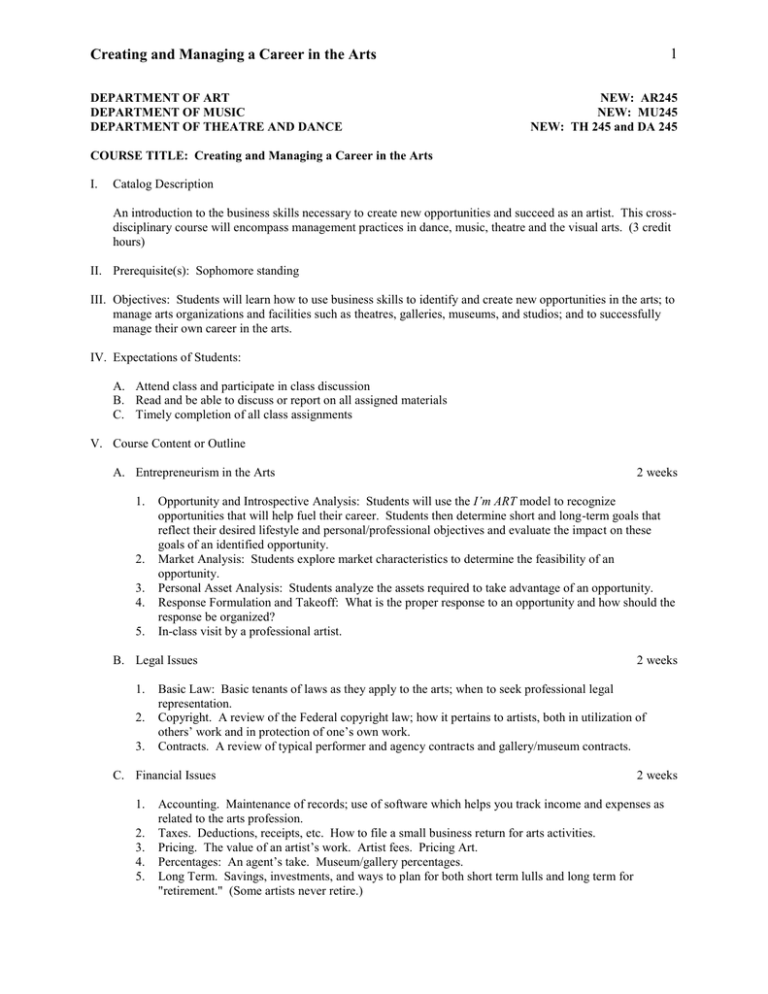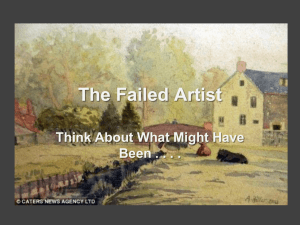AR-MU-TH-DA245
advertisement

1 Creating and Managing a Career in the Arts DEPARTMENT OF ART DEPARTMENT OF MUSIC DEPARTMENT OF THEATRE AND DANCE NEW: AR245 NEW: MU245 NEW: TH 245 and DA 245 COURSE TITLE: Creating and Managing a Career in the Arts I. Catalog Description An introduction to the business skills necessary to create new opportunities and succeed as an artist. This crossdisciplinary course will encompass management practices in dance, music, theatre and the visual arts. (3 credit hours) II. Prerequisite(s): Sophomore standing III. Objectives: Students will learn how to use business skills to identify and create new opportunities in the arts; to manage arts organizations and facilities such as theatres, galleries, museums, and studios; and to successfully manage their own career in the arts. IV. Expectations of Students: A. Attend class and participate in class discussion B. Read and be able to discuss or report on all assigned materials C. Timely completion of all class assignments V. Course Content or Outline A. Entrepreneurism in the Arts 1. 2. 3. 4. 5. Opportunity and Introspective Analysis: Students will use the I’m ART model to recognize opportunities that will help fuel their career. Students then determine short and long-term goals that reflect their desired lifestyle and personal/professional objectives and evaluate the impact on these goals of an identified opportunity. Market Analysis: Students explore market characteristics to determine the feasibility of an opportunity. Personal Asset Analysis: Students analyze the assets required to take advantage of an opportunity. Response Formulation and Takeoff: What is the proper response to an opportunity and how should the response be organized? In-class visit by a professional artist. B. Legal Issues 1. 2. 3. 2. 3. 4. 5. 2 weeks Basic Law: Basic tenants of laws as they apply to the arts; when to seek professional legal representation. Copyright. A review of the Federal copyright law; how it pertains to artists, both in utilization of others’ work and in protection of one’s own work. Contracts. A review of typical performer and agency contracts and gallery/museum contracts. C. Financial Issues 1. 2 weeks 2 weeks Accounting. Maintenance of records; use of software which helps you track income and expenses as related to the arts profession. Taxes. Deductions, receipts, etc. How to file a small business return for arts activities. Pricing. The value of an artist’s work. Artist fees. Pricing Art. Percentages: An agent’s take. Museum/gallery percentages. Long Term. Savings, investments, and ways to plan for both short term lulls and long term for "retirement." (Some artists never retire.) 2 Creating and Managing a Career in the Arts D. Professionalism 1. 2. 3. Timeliness. The importance of being on time not only for performances, but rehearsals, receptions, dinners, etc. The overall impact of promptness on one’s career. Preparation. Rehearse before the performance. Prepare not only for “the event,” but for all of the steps beforehand. Appearance. How to dress and not overdress. What not to wear. Grooming. Personal hygiene. E. Interpersonal Communication: 1. 2. 3. F. 1 week ½ week Conversational Skills: How to talk about something besides yourself. World Knowledge: Reading, films, exhibits, other arts. Etiquette. How to conduct oneself at social gatherings; how to maintain a conversation. Grants and Funding ½ week 1. Grant Sources. National Endowment for the Arts: regional, state, and local agencies; foundations and corporation. 2. Patronage. An old concept but one that still functions to some degree. G. Unions and Associations ½ week 1. An overview of various unions affecting the arts and the artist: American Federation of Musicians, Actors’ Equity, Screen Actors Guild, IATSE, Director’s Guild, and many more. 2. Consortia, a valuable resource and support system. H. Marketing 1. 2. 3. 4. I. Representation. Obtaining an agent. Performances/Exhibits. Basic marketing/advertising techniques and practices. Technical and logistical (preparation, lighting, sound, other equipment. Touring artist or company requirements. Running a Facility or Performance Venue 1. 2. 3. 4. 2 weeks 2 ½ weeks Booking and scheduling Front-of-house (the gallery, the lobby, the ushers and staff). Technical and logistical (preparation, lighting, sound, other equipment). Touring artist or company requirements. VI: Textbook(s) and/or Other Required Materials or Equipment: Management and the Arts, William J. Byrnes, Focal Press (an imprint of Elsevier), Fourth Edition, copyright 2009 by Elsevier Inc.; other handouts as needed. VII. Basis for Student Evaluation: A. B. C. D. Participation in class discussion and activities …………………………….. 40% Periodic quizzes, weekly exercises, assignments ………………………….. 20% Midterm examination ……………………………………………………… 20% Final Examination ………………………………………………………… 20%




